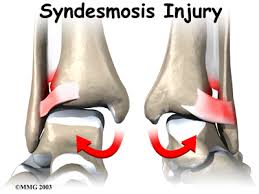Syndesmosis Injuries | Ankle Injury PART 1
The function of this group of ligaments is to hold these bones together and so provide a stable junction between the lower leg and the ankle. An ankle syndesmosis injury involves a sprain of one or more of the ligaments that support the ankle syndesmosis. A sprain stretches or tears the ligaments. The ligament is weakened by the injury. How much it is weakened depends on the degree of the sprain.
A syndesmosis is a joint where the rough edges of two bones are held together by thick connective ligaments.
Only a few joints in the body are syndesmosis joints. The connection of the lower leg bones, the tibia and fibula, is a syndesmosis. The tibia is the main bone of the lower leg. The fibula is the small, thin bone that runs down the outer edge of the tibia. The ankle syndesmosis is held together by three main ligaments.
- The ligament crossing just above the front of the ankle and connecting the tibia to the fibula is called the anterior inferior tibiofibular ligament (AITFL).
- The posterior fibular ligaments attach across the back of the tibia and fibula. These ligaments include the posterior inferior tibiofibular ligament (PITFL) and the transverse ligament.
- The interosseous ligament lies between the tibia and fibula. (Interosseous means between bones.)
The function of this group of ligaments is to hold these bones together and so provide a stable junction between the lower leg and the ankle. An ankle syndesmosis injury involves a sprain of one or more of the ligaments that support the ankle syndesmosis. A sprain stretches or tears the ligaments. The ligament is weakened by the injury. How much it is weakened depends on the degree of the sprain.
An ankle syndesmosis injury occurs when the foot is planted and the body and leg turn in, referred to as external rotation of the tibia and fibula on the foot. These injuries are also sometimes referred to as high ankle sprains.
Symptoms of an Ankle Sydesmosis
Syndesmosis injury Syndesmosis injuries are the most severe sprains of the foot and ankle. They also cause the most problems for people trying to get back to normal activity, especially athletes hoping to resume intense running, cutting, and jumping.
Mild to moderate syndesmosis sprains may at first feel like a routine sprained ankle. Symptoms include pain and swelling on the outside of the ankle and above the ankle. Attempts to turn or twist the injured foot may cause sharp pain in the ankle joint. Pain may radiate upward along the side of the lower leg. And the ankle may feel weak, like it can’t be trusted to hold steady, even during routine activities.

